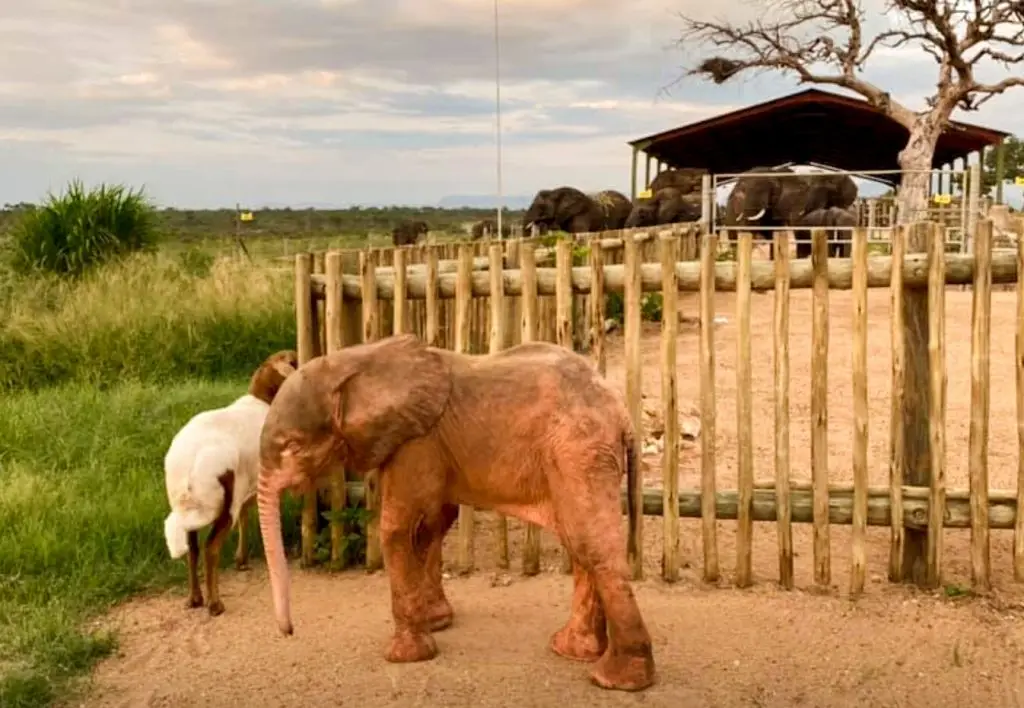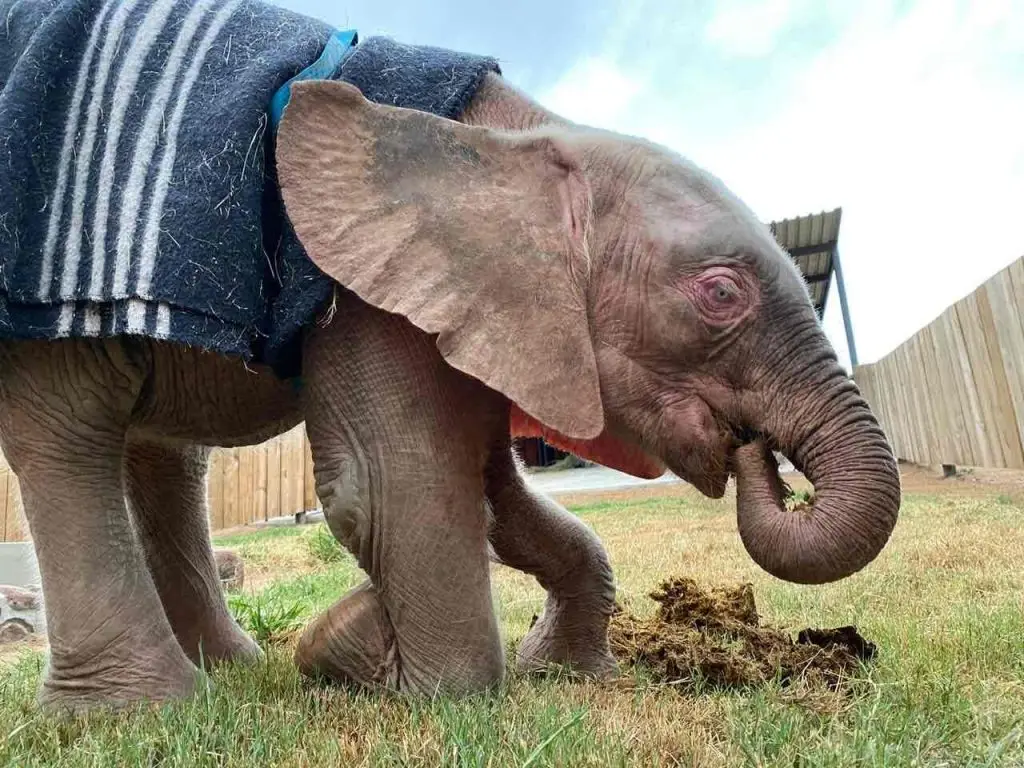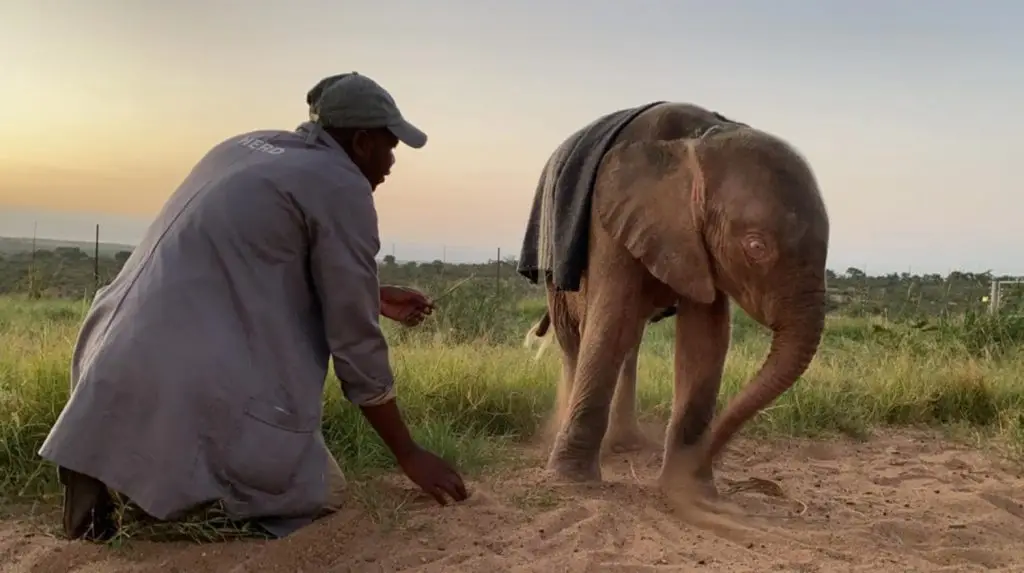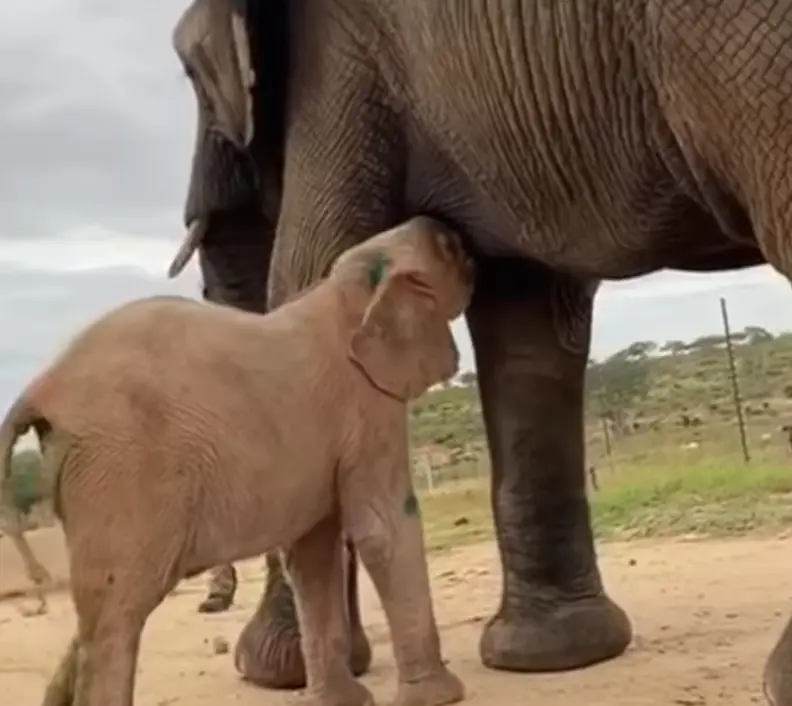Integration of a Baby Elephant into a Wild Herd
The integration of a baby elephant in a new herd is essential to their mental wellbeing and health. However wild herds have been known to reject orphaned elephants, especially when there has been human intervention in caring for the orphans.
The story of the Jabulani Herd
Adine Roode, MD and owner of Jabulani Safari, grew up with that knowledge as her mother Lente Roode saved a baby elephant that was rescued from a deep pool into her care at her wildlife centre HESC (Hoedspruit Endangered Species Centre). This baby elephant was named Jabulani and was rehabilitated successfully, in the warm love of the caring human family Roode. When he was weaned the HESC team tried to introduce him to wild elephant herds. But, he was sadly rejected, after multiple attempts.
In 2002, Lente Roode was asked to consider rescuing a herd of elephants from Zimbabwe whose lives were under threat during the national land reformation. Lente agreed, also with the hope that they would perhaps accept Jabulani.
Fortunately, a few months after the herd arrived and settled, Tokwe, the matriarch still today, showed acceptance and placed her trunk into his mouth and took his little life under her ele-wings, along with the rest of the herd.
The unusual family structure of the Jabulani Herd, the majority of which are orphans themselves, presented a unique solution for orphaned baby elephants in Southern Africa that vitally need to find a second herd to ensure their emotional wellbeing and survival.
With the growing numbers of orphaned baby elephants in South-Africa, the need for a dedicated elephant orphanage grew. The fact that every elephant needs a herd and the presence of the unique structure of the Jabulani herd together with the experience Adine Roode had in raising baby elephants, has lead to the foundation of HERD (Hoedspruit Elephant Rehabilitation and Development) to provide a unique adoptive family structure for baby elephants in need.
The herd has matured over the years and have shown themselves to be the best possible family for the new orphans from HERD. Two orphans have been successfully introduced and welcomed into the Jabulani herd thus far. Showing the herd’s wellbeing and positive adaptation to their home at Jabulani, they have given birth to five calves since 2006.
Baby elephants milk feeding
Baby elephants stay very close to their mothers for the first couple of months. The calves drink their mother’s milk for about two years, sometimes longer. At about four months old, they also begin eating some plants, like adult elephants, but they continue to need as much milk from their mother.
For the first 3 to 5 years, most elephant calves are totally dependant on their mothers for their nutrition, hygiene, migration and health. They learn from mother how to eat in wilderness, so it is really important they learn that from the beginning.
Elephants typically are fully weaned at around 5 to 6 years of age. Being weaned means that the calf no longer drinks milk from its mother, but is able to live only on solid vegetation.
The set up of the orphanage and the Jabulani elephant quarters allows the HERD team to continue providing milk to orphans as they integrate with the herd, until such time that they are weaned, as the Jabulani cows can not offer milk as they are not lactating.
Khanyisa’s integration process
At first: a slow Introduction
Khanyisa is an albino elephant, found trapped in a snare and brought to HERD in January 2020. You can read about her story in our blog. The introduction of Khanyisa has been a slow introduction as the carers need to monitor both Khanyisa and the herd to ensure they are not stressed out or overwhelmed. Adine often leans on the trusted expert elephant advisory team for additional advice and consultation ahead of her decisions and continues to do so through Khanyisa’s integration.
The integration starts as soon as a baby elephant arrives at the orphanage. As the nursing rooms lie alongside the Jabulani elephant stables but divided by fencing, the proximity of the Jabulani Herd stables on the Kapama Private Game Reserve allows baby elephants to communicate without seeing the herd by rumbling and the elephant care team can monitor their emotional and physical progress ahead of the gradual integration with the herd.
Tokwe, the matriarch of the herd, responded in that fase to Khanyisa‘s little rumbles even when the two were far apart, with Khanyisa at the orphanage and Tokwe in the Jabulani stables. Tokwe was very keen and interested to meet Khanyisa.
Getting familiar to the smell of the baby elephant
In the next step of the integration process the Jabulani Herd has to be prepared to meet a new member of the herd. To do this the herd has to become familiar to the smell of the new baby elephant. Therefore Adine goes to meet the Jabulani herd to allow them to smell her and become familiar with the scent of the new baby elephant though they had been communicating with her through the night. Another method to do this is to put some dung of the baby elephant in the neighbourhood of the herd so they can pick up the new smell.
Meeting with barrier
In the next fase Khanyisa and the herd are meeting – with the barrier still between them, but closer together and at a spot near the herd’s stables.
Tokwe, the Matriarch, and the rest of the herd remained calm and peaceful as she approached, communicating with her in the most subtle and gentle ways. If only we know what they were saying.
After this step, they began with giving Khanyisa milk close to the fence. As she drank her milk, a group of females from the herd rumbled and came over. Curiously and calmly, the herd proceeded to smell the little baby and Khanyisa returned the sentiment and sniffed them out closer than ever.
Although Khanyisa had become familiar with Tokwe, the Matriarch, via the fences and they often communicated, she had also made a lovely bond with Jabulani who has taken a vested interest in her wellbeing. He visited Khanyisa most mornings through the fence.
He seemed to have taken on a very protective role from the onset.
Introduction to the big stables
As a next step in the integration phase, Khanyisa is being introduced to the big stables, little by little. This happens when the herd is out in the bush, Khanyisa can experience the smells and sights of her future home, right next door to her current nursery, without added stress or excitement.
During this initial visit, she was a bit overwhelmed by all the new scents. She flared her ears out and her steps were slow and cautious. She was hesitant to walk alone or step forward and preferred to stay close to the carers The care team took her to visit the stables more and more regularly to prepare her for the introduction with the Jabulani herd.
Exercices and exploring beyond the orphanage
While this introduction goes on, Khanyisa has to get in shape . These runs and exercises are important for her health and well-being! Khanyisa will soon have a much bigger wilderness to play and roam in so her growing little bones and muscles, heart and lungs have to be strong and fit. This is especially essential in preparing her for the next phase of her young life.
Along with these exercices, she also has to explore beyond the borders of the orphanage so she can also become accustomed to, all in the protection and guidance of the team and Lammie – her compagnion sheep, of course.
Elephant Dung – a daily snack for Khanyisa!
Every day Khanyisa receives a delivery of fresh dung scooped in the morning from the Jabulani Herd stables. Not to only smell, but also to eat, and she loves it!
Elephant calves are known for this fascinating act, known as “coprophagia”, commonly seen not only in elephants but in other animal species too. Eating their elder’s faeces is an essential part of a baby elephant’s diet, especially when they start to eat more solids.
Why is it essential?
Eating adult elephant dung passes on essential bacteria to an elephant calf that assists them in digesting the vegetation that they eat, a bacteria that they are not able to produce when they are so young. The bacteria help break down plant matter in their intestines.
A baby elephant’s intestines rely on this extra source of bacteria to help them build up their digestive systems as well as their immune systems too.
Another huge advantage of the proximity of the Jabulani herd to the orphanage is the ample availability of fresh dung for the little ones, from their future family.
Introduction trunk to trunk with Jabulani
Khanyisa enjoyed her meetings with elephant bull Jabulani every morning at the fence of the orphanage. Due to her terrible start to life being caught in a snare and abandoned, and the amount of trauma and stress she endured, Adine followed her instincts and decided it would be best to introduce Khanyisa to Jabulani first instead of choosing Tokwe because it would be the least stressful initial introduction for Khanyisa at this stage.
As Adine headed to the stables, Khanyisa followed after her and then the moment came: Jabulani and Khanyisa, no barriers, touching trunks.
So, Khanyisa was introduced in person to Jabulani on 29 March 2020. This was a big step in the elephants accepting Khanyisa!
Of course, it is essential for Khanyisa to be introduced to a female, so that will be the next step in her integration process.
The two elephants meeted up for several times.
At a certain moment something unexpected happened: Khanyisa, showing her natural elephant instincts, reached to big boy Jabulani to suckle on a teat, as she would with her mother. Of course, Jabulani not being her mother and instead a very large male bull, isn’t able to assist. But he lets Khanyisa explore his underside. This is where the team gets a little anxious, since so much can happen in these moments when Khanyisa gets so intimately close to such a big elephant. But Jabulani continued on with his bana grass, munching on even as Khanyisa letted out a snore-like rumble.
When the two of them went on a walk off with Adine and her carers Tigere and Blessmore, she was copying his movements out in the bush on their way to the dam. This is exactly how a calf learns to survive in the wild and shows that the integration was going really good.
Emotional stress and dehydratation
Khanyisa’s condition took a downturn after these meetings. She was having severe diarrhea and she also started becoming a little less energetic than usual. The team at Herd had to adjust the milk formula in order to improve her drinking and had to add in-between feedings in order to keep her rehydrated. An elephant calf needs twelve feedings a day, every 2 hours.
The dung lab results confirmed no trace of any bacterial infection. So her condition could well be due to emotional stress, but it could also be her body’s reaction to teething.
Elephants are extremely intelligent animals that experience lots of emotions, which are often linked to their physical wellbeing, especially when they are so young, making them one of the hardest wild species to hand rear. As it started shortly after being in the physical company of an adult elephant for the first time since her terrifying ordeal just three months ago. Seeing them, touching them and smelling them up close may have stirred up memories of her mother whom she will no doubt miss so much, and it could have reminded her once again of the traumatic experiences she must have endured.
Meeting Lundi, hopefully her future mom
After consideration and agreement by their expert elephant advisory team, they continued with her gradual integration process with the Jabulani herd, knowing that she did not have any bacterial infection.
This continued to reassure her emotionally and build up her confidence in their company.
As the matriarch, Tokwe has her hands full currently with the other little ones in the herd, Adine decided it would be less stressful on Tokwe if Lundi was chosen as the adopted mom to take in Khanyisa.
Moreover Tokwe and Lundi work hand-in-hand in their motherly duties in the herd and Lundi has an excellent level of commitment, responsibility and her caring heart.
Lundi and Khanyisa’s first encounter started in what may seem a little bit of an apprehensive start from Lundi. Lundi must have felt slightly confused and uncertain as she was not with the other cows, as the cows tend to keep together. But she has found comfort with Jabulani and her trusted carers in her company.
Within a short time, Lundi allowed Khanyisa to approach her and even moved her leg to give her full access to suckle from her teat. This was an exceptionally emotional moment for the whole team!
Lundi allowed an elephant calf, different from her own, and of another herd, into her most personal of spaces. We can only fathom the emotions that Khanyisa must have felt, finally finding a natural teat, even though she is not lactating.
Jabulani watched curiously from a distance, keeping an eye on Khanyisa, who occasionally went to him for reassurance, as well as Adine.
To monitor the stress levels, dung from both Khanyisa as from the other elephants of the herd are being examined.
Khanyisa’s family is growing bigger by the day!
After meeting Lundi for several times, Khanyisa was ready to meet other elephants of the herd. First she met Setombe, a fantastic mother to Klaserie. Klaserie, however, was a bit unsure and they were keeping their distance at first until Klaserie started taking a much keener interest day by day. Klaserie did not know how to react when Khanyisa looked for her teat, as she has never been a mother before, so it made her feel a little uncomfortable and she moved away.
Khanyisa has also met Somopane, a great and gentle bull of the Jabulani herd, who slowly strolled over and said hello with his trunk. It was clear that Khanyisa felt very comfortable in his presence, she kept making her way to him and he calmly allowed her to discover his underbelly.
Khanyisa still recognises Lundi as her adoptive mom who is doing such an excellent job with her new responsibility.
Bubi is a gentle and reliable female who is known for her warm affection to younger elephants. Although she is loving, she also has high expectations of youngsters, expecting good manners at all times, and she always leads by example, hence her daughter, Zindoga is also very well-mannered. Zindoga showed very little interest in Khanyisa, however. Bubi has a great interest in Khanyisa too.
Khanyisa had also the good fortune of meeting Sebakwe, the gentle giant of the Jabulani Herd. Sebakwe is the dominant bull and a very kind and caring elephant, though very protective of his herd. He is well known as the Amarula elephant for featuring in various Amarula marketing campaigns over the years.
Khanyisa is in a good space and seems energised after each interaction with her new family.
Khanyisa’s first family walk!
Khanyisa has now met nearly half of the Jabulani herd (which has a total of 15 elephants) : Jabulani, Lundi, Somopane, Setombe, Klaserie, Bubi, Zindoga and Sebakwe.
This has been very positive, and most importantly, Khanyisa is responding well and feeling confident in their company. Klaserie seems to have taken quite an interest in Khanyisa. She is becoming a little bit more at ease with Klaserie now and is starting to spend more time with her too. Lundi, however, remains her significant mother-figure and continuously returns to her for comfort and reassurance.
The team therefore decided to go for a walk on the reserve together.
It was magical and heartwarming to see her walking beside her new family and learning from them every step of the way. You could see that the big elephants were watching their steps as much as she was, and they soon found their rhythm with their new heartbeat of the herd.










